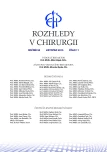Determination of CEA, EGFR and hTERT expression in peritoneal lavage in patients with pancreatic adenocarcinoma using RT – PCR method
Authors:
M. Ghothim 1; J. Srovnal 2; L. Bébarová 3; J. Tesaříková 3; P. Skalický 3; Dušan Klos 3; A. Prokopová 2; M. Vahalíková 2; H. Slavík 2; J. Vrbková 2; Č. Neoral 3; R. Havlík 3; M. Hajdúch 2; M. Loveček 1
Authors‘ workplace:
I. chirurgická klinika LF Univerzity Palackého Olomouc
přednosta: prof. MUDr. Č. Neoral, CSc.
1; Laboratoř experimentální medicíny, Ústav molekulární a translační medicíny LF Univerzity Palackého Olomouc
ředitel doc. MUDr. M. Hajdúch, Ph. D.
2; I. chirurgická klinika FN Olomouc
přednosta: prof. MUDr. Č. Neoral, CSc.
3
Published in:
Rozhl. Chir., 2015, roč. 94, č. 11, s. 464-469.
Category:
Original articles
Overview
Introduction:
The aim of this study is to assess the significance of CEA, EGFR and hTERT as markers of occult tumor cells for predicting treatment outcomes in pancreatic cancers, as well as determining the cut-off values of these markers individually in peritoneal lavage.
Method:
The study compared 87 patients undergoing palliative operations (bypass surgery, biological sampling for subsequent oncological treatment) for either stage III or IV (UICC) pancreatic ductal adenocarcinomas with a control group of 24 healthy patients. Abdominal cavity lavage was performed at the beginning of the surgery in both groups, using 100 ml of physiological solution (phosphate buffered saline, pH 7.2). The samples were transported in bottles containing 1.5 ml 0.5 M EDTA and 10 ml of fetal bovine serum. Total RNA samples were all processed and purified by reverse transcription. Occult tumor cells in the peritoneal lavage were detected by the real-time RT-PCR method using CEA, EGFR and hTERT as markers of tumor cells. Another aim was to calculate the cut-off values of these markers. Statistical analysis was done using software R (www.r-project.org) and Statistica (StatSoft, Inc. USA).
Results:
Mean expression of CEA, EGFR and hTERT in peritoneal lavage in the control group was 2501, 716749 and 104 copies of mRNA / mg RNA. Threshold, cut-off values were determined as the “mean + 2 times standard deviation”. Absolute expression values were further normalized to expression of the house-keeping gene glyceraldehyde-3-phosphate dehydrogenase (GAPDH). After normalization, cut-off values of the tested markers were 4.89, 115.88 and 0.02 copies of mRNA/GAPDH mRNA. As regards absolute expression of the markers tested, only hTERT was able to statistically significantly (p<0.001) distinguish the analysed groups, where patients with advanced pancreatic adenocarcinoma had a higher expression of hTERT. Absolute expression of CEA or EGFR was not able to discriminate between the two groups. The more accurate normalized expression values of the test markers demonstrated a statistically significantly higher expression of hTERT (p<0.005) and CEA (p<0.001) in patients with advanced adenocarcinoma compared to the control group.
Conclusion:
Absolute hTERT expression in peritoneal lavage of patients with advanced pancreatic cancer was significantly higher compared to the control group.
Key words:
pancreatic adenocarcinoma − occult tumor cells − peritoneal lavage − RT-PCR – CEA – EGFR − hTERT
Sources
1. Havlik R, Srovnal J, Klos D, et al. Occult tumour cells in peritoneal lavage are a negative prognostic factor in pancreatic cancer. Biomed Pap Med Fac Univ Palacky Olomouc Czech Repub 2013;157 : 233−8.
2. Okami J, Dohno K, Sakon M, et al. Genetic detection for micrometastases in lymph node of biliary tract carcinoma. Clin Cancer Res 2000;6 : 2326–32.
3. Eguchi H, Ohigashi H, Takahashi H, et al. Presence of minute cancer cell dissemination in peritoneal lavage fluid detected by reverse transcription PCR is an independent prognostic factor in patients with resectable pancreatic cancer. Surgery 2009;146 : 888−95.
4. Klos D, Loveček M, Srovnal J, et al. Možnosti využití stanovení minimální reziduální choroby u adenokarcinomu pankreatu pomocí metodiky real-time RT-PCR – pilotní studie. Časopis lékařů českých 2010;149 : 69−73.
5. Grochola LF, Greither T, Taubert HW, et al. Prognostic relevance of hTERT mRNA expression in ductal adenocarcinoma of the pancreas. Neoplasia 2008;10 : 973−6.
6. Vogel I, Kalthoff H, Henne-Bruns D, et al. Detection and prognostic impact of disseminated tumor cells in pancreatic carcinoma. Pancreatology 2002;2 : 79−88.
7. Broll R, Weschta M, Windhoevel U, et al. Prognostic significance of free gastrointestinal tumor cells in peritoneal lavage detected by immunocytochemistry and polymerase chain reaction. Langenbecks Arch Surg 2001;386 : 285−92.
8. Makary MA, Warshaw AL, Centeno BA, et al. Implications of peritoneal cytology for panceratic cancer management. Arch Surg 1998;133 : 361−5.
9. Yamada S, Fujii T, Kanda M, et al. Value of peritoneal cytology in potentially resectable pancreatic cancer. Br J Surg. 2013;100 : 1791−6.
10. Hoskovec D, Varga J, Konečná E, et al. Levels of CEA and Ca 19 - 9 in the sera and peritoneal cavity in patients with gastric and pancreatic cancers. Acta Cir Bras 2012;27 : 410−6.
11. Campa D, Rizzato C, Stolzenberg-Solomon RZ, et al. The TERT gene harbors multiple variants associated with pancreatic cancer susceptibility. Int J Cancer 2015;137 : 2175−83.
Labels
Surgery Orthopaedics Trauma surgeryArticle was published in
Perspectives in Surgery

2015 Issue 11
Most read in this issue
- Hepatic pseudolesions adjacent to the falciform ligament
- Our experience with the measurement of transcutaneous oxygen tension for evaluation of blood circulation in peripheral arteries in patients with critical ischemic disease of lower limbs
- Surgical therapy of pancreatic cancer – 5 years survival
- Management of groin wound infection after arterial surgery using negative-pressure wound therapy
